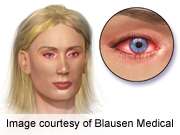Between 2006 and 2010, six outbreaks of human adenovirus-associated epidemic keratoconjunctivitis were reported to the U.S. Centers for Disease Control and Prevention, according to a report published in the Aug. 16 issue of the CDC's Morbidity and Mortality Weekly Report.
(HealthDay)—Between 2006 and 2010, six outbreaks of human adenovirus (HAdV)-associated epidemic keratoconjunctivitis were reported to the U.S. Centers for Disease Control and Prevention, according to a report published in the Aug. 16 issue of the CDC's Morbidity and Mortality Weekly Report.
Eileen Schneider, M.D., of the CDC in Atlanta, and colleagues collected data on the outbreaks, which were reported from the states of Florida, New Jersey, Minnesota, and Illinois. Altogether, 411 cases of the highly contagious infection were documented. Each of the six outbreaks appeared to have been associated with health care transmission in the setting of ophthalmologic examination, but community transmission was noted as well.
The outbreaks affected a substantial number of people, resulting in significant morbidity and cost. The outbreaks also resulted in the temporary closing of a neonatal intensive care unit and several clinics.
"In settings where ophthalmologic care is provided, routine adherence to basic infection control measures and early implementation of enhanced outbreak control measures are essential to prevent HAdV transmission," the authors write.
More information: Full Text
Journal information: Morbidity and Mortality Weekly Report
Copyright © 2013 HealthDay. All rights reserved.
























